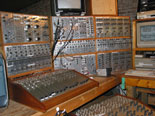Data sheet (Research project):
| Preserving ephemeral works: "Variable Media Network" |
| Title of research project Variable Media Network |
| Location of research project Daniel Langlois Foundation for Art, Science and Technology, Montreal, Quebec, Canada - Guggenheim Museum, New York, New York, United States |
| Participation method Commentaire |
| Theme 1- Conservation of media art |
Observer: Mélanie Avice |
The concept of variable media developed in 1998 by Jon Ippolito, Assistant Curator at the Guggenheim Museum in New York, led to the creation of the Variable Media Network, a research partnership founded by the Guggenheim Museum and the Daniel Langlois Foundation for Art, Science and Technology. The objective of the Variable Media Network is to develop and share the variable media concept, which proposes a new preservation strategy for contemporary works of art based on ephemeral mediums (e.g. digital, interactive and dynamic works). This preservation strategy recommends describing the works by focusing on their behaviours (installation, performance, content, interactive, etc.) rather than on the materials that comprise them. A work is therefore examined in terms of its medium-independent behavior in order to preserve its original intent. The concept of variable media places the artists at the centre of the preservation efforts surrounding their work. According to this approach, the best way to preserve ephemeral works of art is to encourage artists to define their works’ behavioural characteristics in order to help curators and restorers “translate” them into new formats once their original media become obsolete. By providing information on their works and intentions, the artists allow possible preservation strategies to be identified (storage, emulation, migration, reinterpretation). To this end, the Variable Media Network has created an interactive questionnaire for artists. The Variable Media Network collaborates with organizations to develop the tools, methods and standards needed to implement its strategy. To achieve this, the Network: “…pairs artists with museum and media consultants to provoke comparison of artworks created in ephemeral mediums.” (Source: http://www.variablemedia.net/e/welcome.html) To date, eight works have been analyzed using the Variable Media Network concept. They include: A White Wall (Dibbets, Jan, 1971. Photo collage), Bitemporal Vision: The Sea (Jacobs, Ken, 1994. Film performance), Untitled (Public Opinion) (Gonzalez-Torres, Felix, 1991. Interactive installation), Site (Morris, Robert, 1964. Performance), Net Flag (Napier, Mark, 2001. Web site), False Silence (Nauman, Bruce, 1975. Audio installation), TV Garden (Paik, Nam June, 1974. Video installation) and Stick Spiral (Webster, Meg, 1986. Installation). In addition, the Variable Media Network research project has prompted, among others, a publication (Permanence Through Change: The Variable Media Approach), an exhibition (Seeing Double: Emulation in Theory and Practice) and a symposium (Echoes of Art: Emulation as a Preservation Strategy). |
Links: http://www.variablemedia.net/ Variable Media Network [On-line] (Page consulted October 19, 2005) http://www.variablemedia.net/e/preserving/html/var_pub_index.html Permanence Through Change: The Variable Media Approach [On-line] (Page consulted October 19, 2005) http://www.variablemedia.net/e/echoes/index.html Echoes of Art: Emulation as a Preservation Strategy [On-line] (Page consulted October 19, 2005) |


